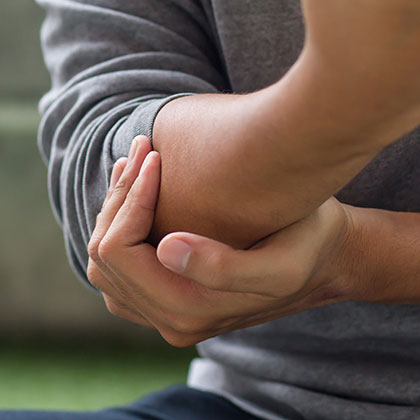Repetitive strain injury (RSI) is a general term for conditions that affect the muscles, tendons, ligaments, nerves, other soft tissues and joints, causing pain and other symptoms. Also called upper limb disorders (ULDs), these conditions generally affect the neck, shoulders, arms, wrists, hands and fingers (carpal tunnel syndrome, for example, is a common type of RSI that affects the wrists and hands)
Many people may associate RSI with overworked office staff who spend their days hunched over computer keyboards or factory workers using heavy machinery. But it can affect anyone who makes frequent, repetitive movements, either at work or at play (some sports, for instance, can lead to the development of RSI). Even children are at risk of developing RSI because of the way computer games consoles, smartphones and other digital devices are operated.
Apart from making repetitive moments such as twisting, squeezing, hammering, pushing, pulling, lifting and reaching, there are other factors that may contribute to the development of RSI, including the following:
-
Uncomfortable, awkward or poor working postures
-
Holding the same posture for long periods
-
Using vibrating machinery
-
Working for long periods without breaks
-
Badly organised working environments
-
Badly designed equipment
-
Cold temperatures
-
Fatigue
-
Stress
How many people have RSI?
According to the Health and Safety Executive, there were 203,000 reported cases of work-related ULDs during 2018/19 (i). More detailed statistics on RSI cases are difficult to find, since RSI is usually grouped with other musculoskeletal conditions, such as back and lower limb conditions. However one American study suggests 68 per cent of female high-school runners and 59 per cent of male runners have a history of overuse injuries, of which RSI is one (ii).
Another study suggests that the number of repeated trauma cases accounts for four per cent of overall workplace injuries and 65 per cent of all occupational illnesses, with work-related upper limb disorders accounting for most cases (iii).
Meanwhile according to the TUC, manual workers – both skilled and unskilled – are most at risk of developing RSI, with older workers reporting more problems than younger workers. Women workers are also more at risk than men, as are those who are in less secure employment such as people on fixed-length contracts (iv).
What are the symptoms?
As well as aches, pains and tenderness, RSI can cause stiffness, tightness, tingling, numbness, weakness, cramp and throbbing. Symptoms often develop gradually rather than suddenly, and initially you may only be affected while you’re doing whatever action is causing the problem (that is, the symptoms wear off when you’re at rest). Symptoms can sometimes resemble the pains associated with sports injuries or strains, so it’s important to differentiate between the two.
However, if you don’t take steps to relieve or prevent the symptoms, they may gradually become worse and you may be affected for longer periods or even all of the time.
Types of RSI
RSI injuries are often divided into two categories: type 1 and type 2. Type 1 RSI includes well-defined syndromes, such as the following:
Bursitis
Also called beat elbow or 'frozen shoulder’, bursitis is inflammation of the soft tissue between either the skin and bone or between the bone and tendon (cords that connect the muscles to the bones), causing pain and swelling. It's thought to be caused by pressure on the elbow and repetitive shoulder movements.
Carpal tunnel syndrome
Caused by pressure on the median nerve that passes through the wrist, carpal tunnel syndrome symptoms include pain, tingling and numbness in the fingers and thumb. Using vibrating tools as well as working with a bent wrist – such as at a computer keyboard – may cause it.
Cellulitis
Sometimes called beat hand, cellulitis affects the palm of the hand, causing pain and swelling as a result of using hand tools such as hammers and shovels.
Dupuytren's contracture
This is a hand condition where the fingers – sometimes just the ring and little fingers – bend towards the palm and cannot be straightened, caused by the thickening of scar tissue under the skin on the palm. It may be seen alongside other RSI problems, such as bursitis or tendinitis.
Epicondylitis
Most commonly known as tennis elbow, epicondylitis is the term for inflammation of the tendons at the point where they attach to the bone, causing pain and swelling. It's linked to strenuous jobs such as bricklaying.
Ganglion
Cysts that form under the skin, ganglions are usually found on the back of the fingers or wrist, and are caused by repetitive hand movements. The swelling may feel tender, though ganglions are often painless.
Rotator cuff syndrome
This is the term for tendinitis in the rotator cuff (the soft tissue at the top of the shoulder). It causes inflammation in the shoulder muscles and tendons, resulting in pain and restricted movement. Rotator cuff syndrome is usually seen in people who reach up a lot with their arms, such as painters, plasterers, swimmers and tennis players.
Tendinitis
Caused by inflammation of the tendons, tendinitis can affect the hands, wrists, shoulders or elbows and develops as a result of overusing of a group of tendons.
Tenosynovitis
Mostly affecting the hands, wrists and arms, tenosynovitis is caused by inflammation of the tendons as well as the protective sheaths that surround some tendons. Symptoms include aches, pain, tenderness and swelling.
Trigger finger
This is inflammation of the flexor tendons of the hand, which makes it difficult for fingers and thumbs to bend on their own. It's thought to be caused by repetitive movements and having to grip objects for long periods of time.
Writer's cramp
This term is often used to describe muscle cramp caused by repetitive movements such as handwriting and typing.
Type 2 RSI (or non-specific upper limb pain), on the other hand, is when you have pain that cannot be diagnosed as one of these or any other specific condition.
Treatments for RSI
The simplest way to treat RSI is to stop doing the movements that are causing it. There again, if your RSI is related to your work, that may not be possible – although some people may be able to change what they do at work or modify their working environment, either of which can help.
If you can’t stop or modify your actions at work, several things may help to relieve your symptoms on a temporary basis, including the following:
-
Medicines
You may be prescribed medication such as anti-inflammatory painkillers, muscle relaxants or low-dose antidepressants. -
Drug-free relief
Items used to relieve strains, sprains and other injuries may also be helpful, such as heat and cold packs, splints and elastic sports supports that help relieve the pressure on your joints. -
Steroid injections
If you have a type of RSI that’s causing a well-defined area of inflammation – such as carpal tunnel – you may be advised to have one or more steroid injections to reduce the inflammation. -
Physiotherapy
Your GP may refer you to a physiotherapist (or you could see a physiotherapist privately). He or she may show you exercises to help stretch and strengthen particular muscles or offer ultrasound or infrared wave therapy. A physiotherapist may also be help you improve your posture and offer treatments such as ultrasound therapy, infrared wave treatment and transcutaneous electrical nerve stimulation (TENS). -
Surgery
In certain cases that involve problems with nerves or tendons – such as carpal tunnel syndrome or Dupuytren’s contracture – surgery may be recommended -
Other therapies
Many people also turn to complementary therapies to treat the symptoms of RSI, including chiropractic, osteopathy, acupuncture, reflexology, the Alexander technique and massage therapy. Exercise such as swimming may also be useful in easing some of the symptoms such as muscle stiffness.
Protect yourself against RSI
There are steps you can take to help protect yourself against RSI, especially if your job is putting you at risk.
Breathe deeply
The NHS also recommends trying breathing exercises if you’re stressed (v).
-
Take a break
Regular, short breaks instead of one long break during your working day can help if you do have to perform frequent, repetitive movements. Taking a few minutes every now and then to do some simple stretching movements using your arms, hands, shoulders and neck can also help your circulation and relieve the effects of bad or static postures. -
Adjust your workstation
If you work at a computer, your sitting position at your desk is highly important. Ideally you should adjust your chair so that your upper arms and forearms form 90-degree angles while you type, and your feet are comfortably flat on the floor (you may need a foot rest, depending on how high you have to adjust your chair so that your arms fall in the correct position). Your eyes should be level with the top of your computer screen and your lower back should be supported by the back of your chair. For more information on adjusting your desk, visit the Worksmart website. -
Learn to type
If you use a computer keyboard for long periods of time, either at work or at home, using the correct typing technique can also help as typing with two fingers can put a strain on your finger joints. If you can touch type, you can also look straight ahead while you type instead of constantly looking down at the keyboard and up again, which may put a strain on your neck. You may also want to look into different types of non-standard keyboards, which may help by improving the positioning of your hands. If you find using your mouse uncomfortable, there are also alternative types available that are operated using a different hand position. -
Use a headset
Gripping a phone between your ear and shoulder can put a big strain your neck muscles. So if you spend a lot of your day on the phone, try switching your handset for a headset.
Meanwhile if you want to avoid developing a sports-related RSI, sensible precautions such as warming up and cooling down properly may help protect against muscle strain.
Natural relief for RSI symptoms
As well as conventional treatments, there are some natural supplements and treatments that may help to relieve symptoms such as inflammation and swelling, as well as support nerve and muscle health:
Turmeric
A herb widely used in Indian cooking, turmeric adds colour and flavour to curry dishes and has long been used in the traditional Indian system of herbal medicine called Ayurveda. It contains an antioxidant substance called curcumin, which is widely thought to have anti-inflammatory properties (vi).
Fish oils
The omega-3 fatty acids found in fish oils are also believed to have an anti-inflammatory action. In one study, people with acute and chronic non-specific neck and back pain were given omega-3 fatty acid supplements alongside prescription anti-inflammatory painkillers. After 75 days, 59 per cent had stopped taking painkillers while 88 per cent said they wanted to carry on taking the supplements (vii).
If you’re a vegetarian or vegan you can still benefit from an omega-3 supplement, thanks to the availability of products that contain the natural triglyceride (TG) form of omega-3, which is sourced from plant organisms called microalgae rather than fish oils.
Magnesium
A mineral that may be useful for general muscle health, magnesium is found naturally in the body (the average adult has about 25g), with just over half found in the bones and the rest in soft tissues. It’s needed for more than 300 different biochemical reactions, including muscle and nerve function. If you don’t have a sufficient level of magnesium in your body, one of the symptoms may be muscle cramps or twitches. However, it’s thought that many people in the UK don’t get enough magnesium in their diet.
B Vitamins
The group of B vitamins – and especially vitamin B6 – is believed to help maintain healthy nerves. There is even some evidence that those with a specific type of RSI – namely carpel tunnel syndrome – may be deficient in vitamin B6 (viii).
PEA
Also known as palmitoylethanolamide, PEA is a type of fatty acid made naturally by the body and found in all cells, tissues and fluids including the brain (it’s also found in foods such as soya beans, peanuts, eggs, flaxseed and milk). Described as an endocannbinoid-like chemical that belongs to a family of fatty acid compounds called amides (ix), PEA is an alternative to CBD, since both substances are thought to have similar properties including the ability to reduce pain and inflammation. However researchers suggest PEA is safer than CBD, since it has been studied more extensively and has a more robust safety profile (x) with no known side effects (ix).
Your body naturally increases its production of PEA when your cells are damaged or threatened. But in certain situations – such as when your body is experiencing chronic inflammation – the level of PEA in your cells drops (xi). When this happens, PEA supplements may be helpful. In fact one study suggests PEA supplements may help protect against inflammatory and neuropathic pain caused by at least one type of RSI, namely carpel tunnel syndrome (xi).
Meanwhile, therapies you could try include acupuncture, and magnet therapy (there is some evidence to suggest that magnets may offer relief of carpal tunnel symptoms) (xii).
Repetitive strain injuries can be painful and debilitating, so it’s important to try and treat them as soon as possible to avoid permanent damage. Following the tips above will help you do this.
For more advice on treatment of common conditions, read the dedicated resources in our health library.
References:
-
Available online: http://www.hse.gov.uk/statistics/causdis/msd.pdf
-
Tenforde AS. et al., Overuse injuries in high school runners: lifetime prevalence and prevention strategies. PM R. 2011 Feb;3(2):125-31. Available online: https://www.ncbi.nlm.nih.gov/pubmed/21333951?dopt=Abstract
-
Giang GM. Epidemiology of work-related upper extremity disorders: understanding prevalence and outcomes to impact provider performances using a practice management reporting tool. Clin Occup Environ Med. 2006;5(2):267-83, vi. Available online: https://www.ncbi.nlm.nih.gov/pubmed/16647648?dopt=Abstract
-
Available online: https://worksmart.org.uk/health-advice/illnesses-and-injuries/work-illnesses/rsi/who-can-get-rsi
-
Available online: https://www.nhs.uk/conditions/repetitive-strain-injury-rsi/
-
Kocaadam. B., Sanlier N., Curcumin, an active component of turmeric (Curcuma longa)< and its effects on health. Crit Rev Food Sci Nutr. 2017 Sep 2;57(13):2889-2895. Available online: https://www.ncbi.nlm.nih.gov/pubmed/26528921
-
Maroon. JC, Bost. JW. Omega-3 fatty acids (fish oil) as an anti-inflammatory: an alternative to nonsteroidal anti-inflammatory drugs for discogenic pain. Surg Neurol. 2006 Apr;65(4):326-31.
-
Ellis. JM, Kishi. T, Azuma. J, et al. Vitamin B6 deficiency in patients with a clinical syndrome including the carpal tunnel defect. Biochemical and clinical response to therapy with pyridoxine. Res Commun Chem Pathol Pharmacol. 1976;13:743-757.
Aufiero E. et al., Pyridoxind hydrochloride treatment of carpal tunnel syndrome: a review. Nutr Rev. 2004 Mar;62(3):96-104. Available online: https://www.ncbi.nlm.nih.gov/pubmed/15098856 -
Clayton P. et al., Palmitoylethanolamide: A Natural Compound for Health Management. Int J Mol Sci. 2021 May;22(10): 5305. Available online: https://www.ncbi.nlm.nih.gov/pmc/articles/PMC8157570/
-
Clayton P. et al., Palmitoylethanolamide: A Potential Alternative to Cannabidiol. J Diet Suppl. 2021 Nov;28;1-26. Available online: https://www.tandfonline.com/doi/full/10.1080/19390211.2021.2005733
-
Conigliaro R. et al., Use of palmitoylethanolamide in the entrapment neuropathy of the median in the wrist. Minerva Med 2011 Apr;102(2):141-7. Available online: https://pubmed.ncbi.nlm.nih.gov/21483401/
-
Colbert. AP, Markov. MS, Carlson. N, Gregory. WL, Carlson. H, Elmer. PJ. Static magnetic field therapy for carpal tunnel syndrome: a feasibility study. Arch Phys Med Rehabil. 2010;91(7):1098-1104.
Carter. R, Aspy. CB, Mold. J. The effectiveness of magnet therapy for treatment of wrist pain attributed to carpal tunnel syndrome. J Fam Pract. 2002;51(1):38-40.
Related Posts
Disclaimer: The information presented by Nature's Best is for informational purposes only. It is based on scientific studies (human, animal, or in vitro), clinical experience, or traditional usage as cited in each article. The results reported may not necessarily occur in all individuals. Self-treatment is not recommended for life-threatening conditions that require medical treatment under a doctor's care. For many of the conditions discussed, treatment with prescription or over the counter medication is also available. Consult your doctor, practitioner, and/or pharmacist for any health problem and before using any supplements or before making any changes in prescribed medications.

Christine
Christine Morgan has been a freelance health and wellbeing journalist for almost 20 years, having written for numerous publications including the Daily Mirror, S Magazine, Top Sante, Healthy, Woman & Home, Zest, Allergy, Healthy Times and Pregnancy & Birth; she has also edited several titles such as Women’ Health, Shine’s Real Health & Beauty and All About Health.
View More



